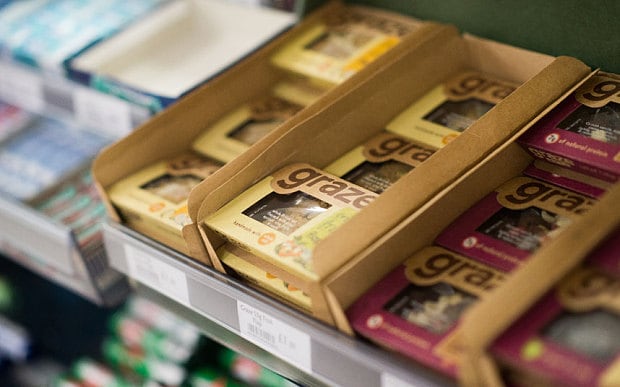Graze: Using data to provide the perfect snack box

A snack provider that is using data to customize offerings based on your palate
Graze started off as an online subscription based food retailer providing a range of over 100 nutritious snacks in a customized box. Founded in the UK in 2008 and launched in the US in 2013, Graze has shipped millions of snack boxes via both online and offline channels. The company has approximately 500 employees and generated sales of 70m pounds in 2016 with an EBITDA of 7.6m pounds.
Value Creation with Data Analytics
Graze prides itself on using big data and analytics to curate boxes that are comprised of 4 or 8 snack combinations as per customers’ dietary specifications and tastes – information on preferences is received via a taste algorithm called “DARWIN” (Decision Algorithm Rating What Ingredients Next) which is run several thousand times a day. The user is prompted to give preferences of the snacks on the website and also ratings of snacks from previous Graze boxes which ensures customers don’t get something they dislike. Unlike its competitors such as Nature Box, Love with Food, and Healthy Surprise, most of whom buy or get products from food manufacturers, Graze develops its own recipes based on customer inputs. This allows the company to provide healthier snacking options that are free of genetically modified ingredients, or artificial sweeteners. Another way Graze creates value is via its strong tech team that manages everything from the website, CRM, manufacturing and even planning and logistics – an aspect that allows the company to create, package and market new offerings quickly, sometimes within 24 hours. Given the scale it has reached, Graze has 300 million customer ratings and gets over 15000 new customer ratings / hour which increases switching costs for users since the longer a consumer stays, the more tailored his/her snack box becomes. This data also helps Graze to curate boxes for distribution at offline retailers such as Walgreens, Shop Rite and Hannaford in the US and Sainsbury in the UK.
Value Capture
Graze captures value by charging either $7 for a 4-snack box or $12 for an 8-snack box. The pricing is on a per box basis and there are options to ship either once a week, once a month or twice a month as per the subscription. The company also offers bags of specific ingredients or snacks at various price points.
Challenges
Surely Graze had challenges initially since without users, it couldn’t get data to help it tailor the snacks as well. Going forward, with competition on the rise, the company will need to better use the data and differentiate its offerings since there are a growing number of companies using data to determine customer preferences. Also, it will be important for Graze to create channels for more detailed feedback such as why a particular product wasn’t good and what they could change to make that product better (e.g. increase or reduce sugar, salt etc.). As the company expands its distribution via offline channel partners, it will need to ensure its app and platform are able to extract data from third party ERP systems and at the same time get better quality data from consumers who purchased products from offline retailers – a growing portion of its revenue.
Sources
- https://www.theregister.co.uk/2016/06/16/online_graze_in_reverse/
- http://nypost.com/2014/04/21/which-snack-subscription-service-is-best-suited-for-you/
- https://www.nytimes.com/2015/09/26/business/with-subscription-snacks-entrepreneurs-think-inside-the-box.html?_r=0
- http://lifehacker.com/subscription-snack-showdown-graze-vs-naturebox-1772546968
- https://www.earthsfriends.com/love-with-food-vs-naturebox-vs-graze-vs-urthbox/
- https://www.earthsfriends.com/graze-reviews/
- https://www.theguardian.com/business/2016/oct/17/graze-aims-for-healthy-bite-of-us-snack-market-with-bricks-and-mortar





This sounds both interesting and delicious. The most interesting part is that while they develop the recipes themselves, they also sell them in stores which means they have multiple points to monetize consumers. However, consumers who buy Graze products in store don’t give feedback to the company, so it’s important for Graze to keep a strong subscription box base. Does Graze provide any incentive to subscribe, or do they incentivize feedback even from in-store purchases?
Rahul – Interesting read. Having worked at Grubhub, any food-related start-up excites me! 🙂
Can you elaborate a bit more on what all data are they capturing from customers? and what all data are they using to curate the product selection? Do they use it to also build a personalized recommendation engine for a user? You mentioned about 15000 new customer ratings every day. Curious what all information they capture in the ratings. Given their box has 4-8 different types of snacks, even 1 bad snack can ruin user’s experience while other 7 might be really good. So, to my mind, it becomes important to collect snack-level data.
And I would love to try Graze, send me a promo code it you have one. 🙂
Nice read Rahul.
One thing I am curious about is that you mentioned about being able to collect data from 3rd party ERP systems – my question is who are these 3rd party ERP players and why would they be inclined to share their data with Graze?
The second thing I would like to know about is are all products essentially crowd sourced or does Graze experiment reasonably with inputs from nutrition scientists / dieticians?